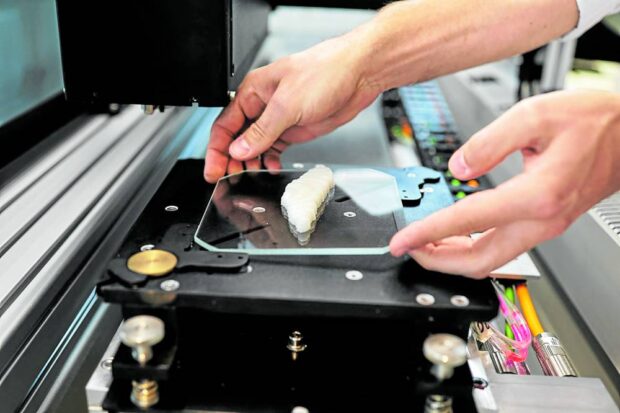3D printers spawn new kind of fish to fry

FROM PRINTER TO PAN | A worker removes a piece of cultivated grouper fish from a 3D printer at Steakholder Foods in Rehovot, Israel, in this photo taken on April 23, 2023. (REUTERS)
REHOVOT, Israel — Forget your hook, line, and sinker. An Israeli food-tech company says it has 3D printed the first ever ready-to-cook fish fillet using animal cells cultivated and grown in a laboratory.
Lab-grown beef and chicken have drawn attention as a way to sidestep the environmental toll of farming and tackle concerns over animal welfare, but few companies have forayed into seafood.
Israel’s Steakholder Foods has now partnered with Singapore-based Umami Meats to make fish fillets without the need to stalk dwindling fish populations.
Umami Meats extracts cells—for now from grouper—and grows them into muscle and fat. Steakholder Foods then adds them to a “bio-ink” suited for special 3D printers. The outcome: a narrow fillet that mimics the properties of sea-caught fish.
Target markets
Umami hopes to bring its first products to market next year, starting in Singapore and then, pending regulation, countries like the United States and Japan.
Article continues after this advertisementCell cultivation alone is still too expensive to match the cost of traditional seafood, so for now the fish cells are diluted with plant-based ingredients in the bio-ink.
Article continues after this advertisement“As time goes by, the complexity and level of these products will be higher, and the prices linked to producing them will decrease,” said Arik Kaufman, the chief executive of Steakholder Foods.
A glass dish slides back and forth in the 3D printer, the white finger-length fillet building mass with each pass. It has the flakiness of traditional fish and when fried and seasoned it is hard to tell the difference.
The process is simpler than with beef, but there are some disadvantages.
Still many unknowns
Cow stem cells have been studied extensively but much less is known about fish, said Umami’s chief executive, Mihir Pershad.
“We have to figure out what the cells like to eat, how they like to grow, and there’s just not so much literature to start from,” he said. “The number of scientists, you can imagine, working on fish stem cell biology is a small fraction of those working on animal cells and human cells.”
They have figured out a process for grouper and eel and hope to add three other endangered species in the coming months, he said.
Meeting the price of fish from the sea is a key challenge.
“We want consumers to choose based on how it tastes and what it can do for the world and the planetary environment. And we want to take cost off the table as consideration,” Pershad added.